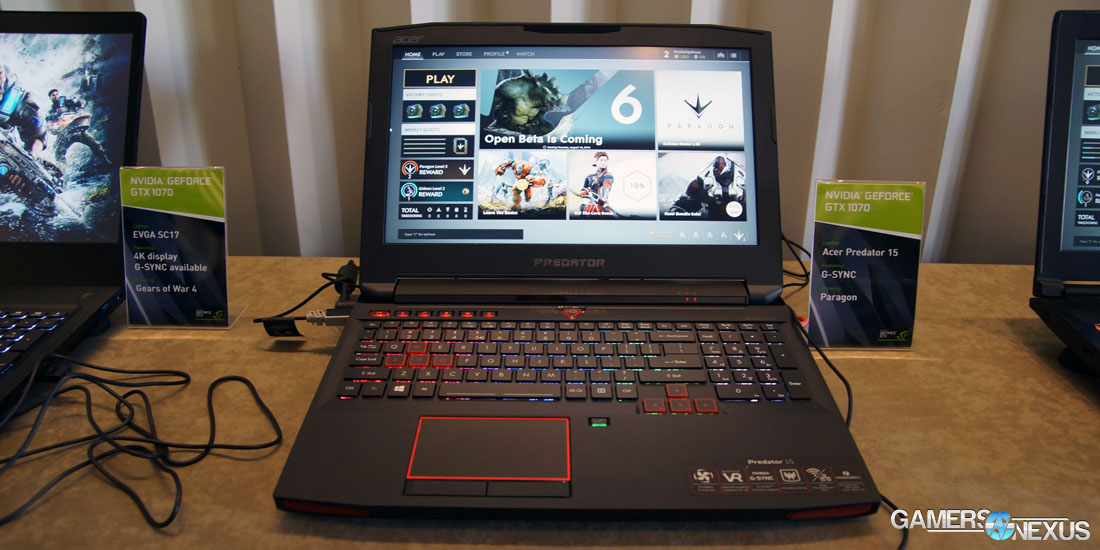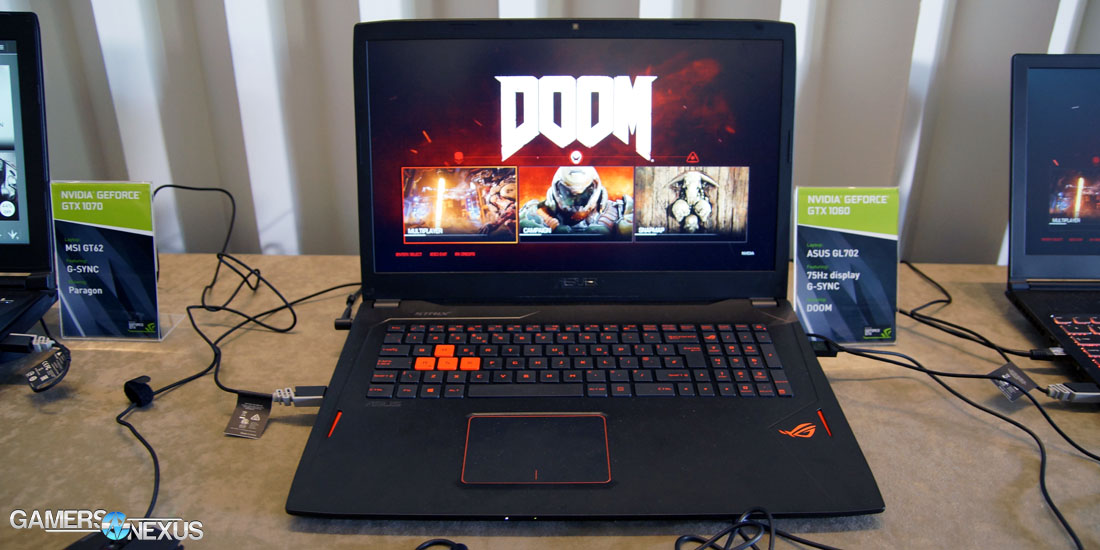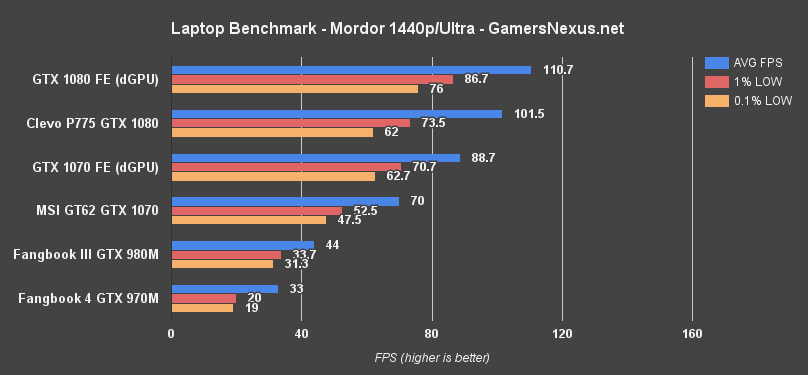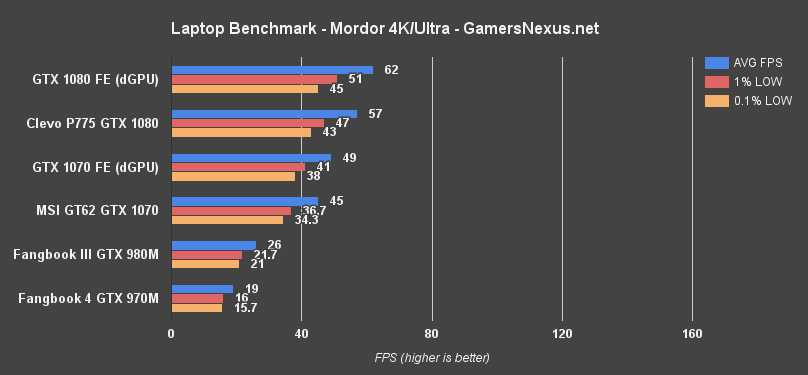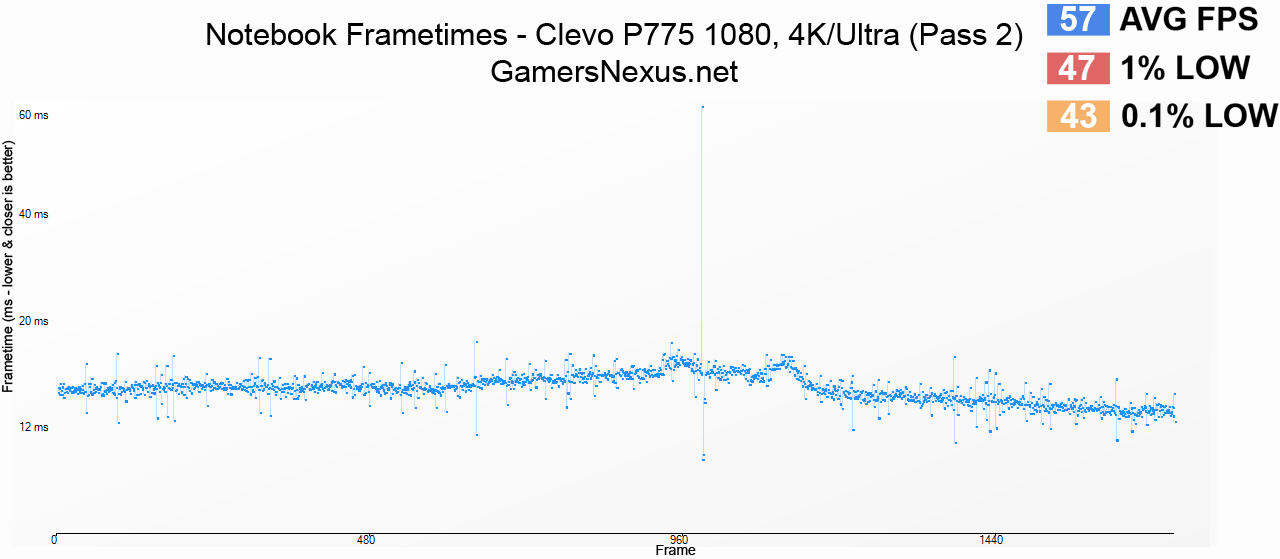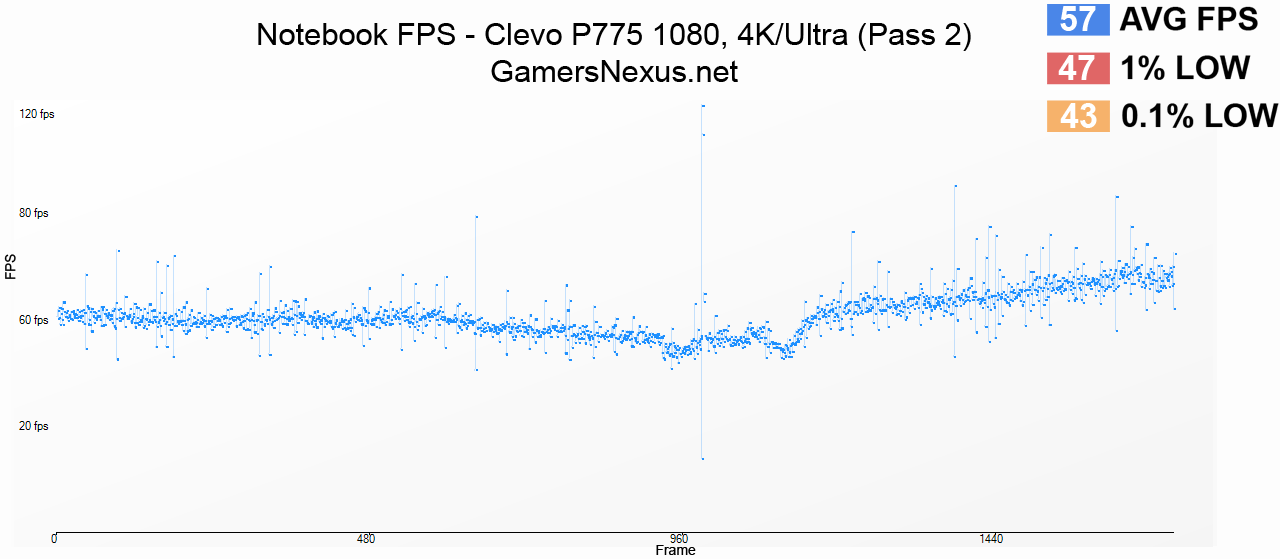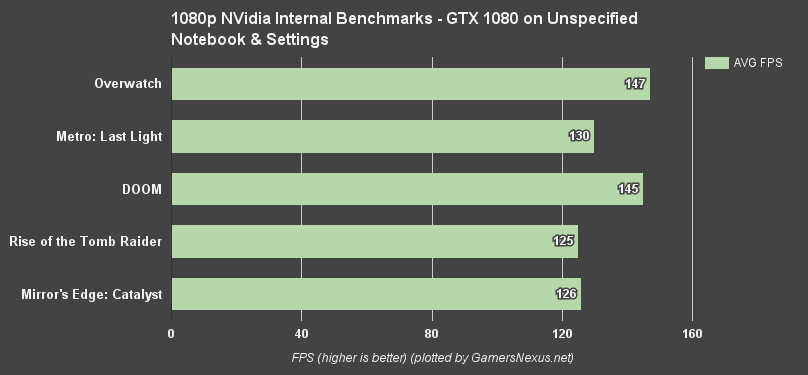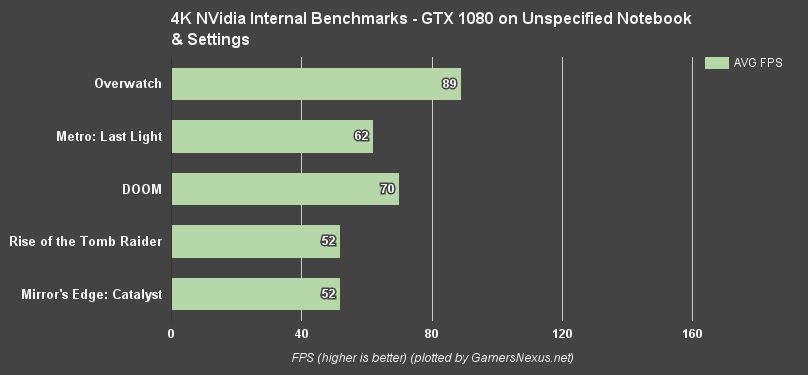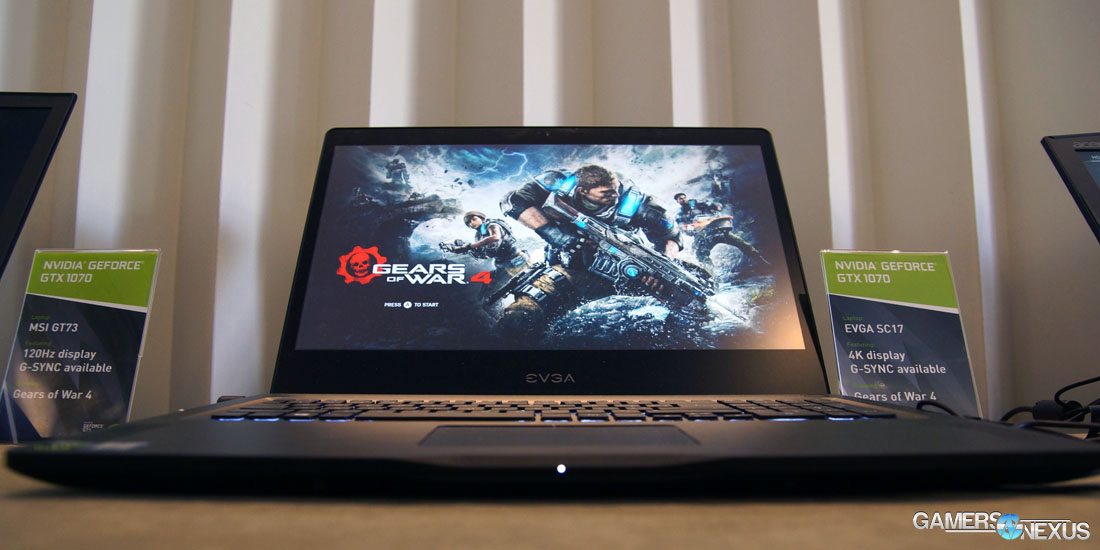Pascal has mobilized, officially launching in notebooks today. The GTX 1080, 1070, and 1060 full desktop GPUs will be available in Pascal notebooks, similar to the GTX 980 non-M launch from last year. Those earlier 980 laptops were a bit of an experiment, from what nVidia's laptop team told us, and led to wider implementation of the line-up for Pascal.
We had an opportunity to perform preliminary benchmarks using some of our usual test suite while at the London unveil event, including frametime analysis (1% / 0.1% lows) with Shadow of Mordor. Testing was conducted using the exact same settings as we use in our own benchmarks, and we used some of our own software to validate that results were clean.
Before getting to preliminary GTX 1080 & GTX 1070 notebook FPS benchmarks on the Clevo P775 and MSI GT62, we'll run through laptop overclocking, specification differences in the GTX 1070, and 120Hz display updates. Note also that we've got at least three notebooks on the way for testing, and will be publishing reviews through the month. Our own initial benchmarks are further down.
Mobile GTX 1080, 1070, & 1060 Specs
| GTX 1080 (Notebook) | GTX 1070 (Notebook) | GTX 1060 (Notebook) | |
| CUDA Cores | 2560 | 2048 | 1280 |
| Boost Clock | 1733MHz | 1645MHz | 1670MHz |
| Memory Config | 8GB GDDR5X 10Gb/s | 8GB GDDR5 8Gb/s | 6GB GDDR5 8Gb/s |
Differences Between Desktop & Notebook GTX 1080, 1070, & 1060
Previous generations have run cut-down or modified versions of desktop chips for portable devices, generally slapping an “M” at the end of the GPU name. This approach was necessary when hardware consumed more power, but the convention was dropped with last year's 980. As we explained there, reduced power consumption assists in managing the thermal envelope, which simplifies cooling requirements to a level achievable within cramped spaces. With these older M-series chips (from both AMD and nVidia), features were disabled or limited to assist in reducing that thermal envelope – changes have often been made to core count or clock-rate (or both) as a means to achieve lower power consumption. Memory speed has also seen reductions in most notebook architectures, a convention from which nVidia has departed with the 10-series GPUs. The GTX 1080 in notebooks will feature its full 10Gbps GDDR5X, as in the desktop counterpart, and the 1070 and 1060 units will use 8Gbps memory.
Above: Acer Predator 15 with GTX 1070.
There are few differences between this generation of Pascal desktop and Pascal laptop GPUs. Only the GTX 1070 has any stand-out modifications, with its increased core count (2048 laptop vs. 1920 CUDA Cores desktop) and reduced clock-rate. The GTX 1070 desktop card operates at a reference base/boost of 1506/1683MHz, with the laptop units suggested for operation at 1645MHz boosted. As with AIB partner video cards, laptop manufacturers have some level of control over a factory OC, permitting a range of ~10% on the stock clock-rate.
There's no hard TDP for the GTX 10 series cards as found in notebooks. NVidia has a thermal and power specification that manufacturers must meet, but the cooling is ultimately up to OEMs at the end of the day – and TDP is more a measure of cooling requirements than anything else. Manufacturers will set their own skin temp specifications and design their own cooling solutions.
Laptop Displays Now 120Hz at 1440p
Alongside arrival of Pascal on portables, manufacturers will begin supporting 120Hz displays, with at least one unit promised as 1440p at 120Hz. The rest will largely be 120Hz at 1080p, with a few of the more standard 75Hz and 60Hz displays filling the lower end. Laptop panels will span up to 4K resolution on some units, with OEM-decided availability of G-Sync (which does not require a physical module on mobile).
This shift aligns with our observed increase in gaming performance at 1440p and 4K, reported on in the GTX 1060 review most recently (though also the GTX 1080, 1070, and RX 470 & 480 reviews). NVidia also reports an internal 30% growth YOY in notebook sales, with a 20M install base that nVidia readily compared to the Xbox One and PS4 install bases. Respectively, those units are at 29M and 52M installs, posting a respective growth of -4% and +4% sales. Notebook technology is advancing to a point that it will begin achieving enthusiast-level performance and display demands. By “enthusiast-level,” we're talking about what most readers of this site demand: High-performance, non-hamstrung gaming.
Pascal Notebook Electrical Design
Above: ASUS GL702 with GTX 1060 (new chassis).
NVidia informed us that the company's electrical design will largely resemble what was found with the Pascal desktop components. This includes dual-FET power supply, permitting increased power density to support higher GPU power in a smaller space.
A focus on power efficiency has necessitated multi-phase power control – something we'll explore upon dismantling our first review unit and analyzing the PCB – and theoretically reduces total watt draw from battery (reduced consumption during voltage/current conversions).
Reducing power consumption aids notebooks in two (likely obvious) ways: Longer run-time on battery and lower thermals under load. All of Pascal's existing power optimization remains true on the notebooks, including clock gating, datapath optimization, and low-level algorithms that allow compute preemption or instruction-level interrupts and resumes on command processing. Read about GP104 architecture here, or GP100 artchitecture here.
Overclocking Support, Performance, & Thermal Throttle Points
Manufacturers are capable of pre-overclocking their variants on the GTX 1060, 1070, and 1080, with approximately a 10% headroom for play in that clock-rate. Through Afterburner and pending software solutions (like Precision), users will also be given comparable core and memory clock slider control to the desktop equivalents. We were not given a hands-on overclocking demo while at the press conference, but did watch a live demo (with enough “oops” moments to confirm it was, in fact, a live overclock). Overclocking the laptop GPUs is done by modifying core clock and memory clock as usual, but makes some changes.
One of those is the elimination of power % target control, or the ability to increase the GPU's power consumption at the expense of higher thermals. With notebooks, this is reasonably disabled; there's no room within the thermal envelope to support increased power draw. We asked if over-voltage and under-voltage would be possible for notebooks, and received a resolute “no.” Further discussion revealed that the notebook components will follow similar volt-frequency curves as discussed in our GTX 1080 OC review, and users may modify DPM volt-frequency configurations to some limited extent. There will be no support to exceed the maximum or minimum values that are pre-configured within the DPM states. Scan functionality will also be supported, as with EVGA's ScanOC.
Without over- and under-voltage, we'll see how useful manual volt-frequency plotting is. Thus far, for enthusiasts, we haven't found a truly solid reason to detour off the path of manual slider OCing.
When we asked about fan curve customization on notebooks, nVidia informed us that fan speed control would be up to the manufacturers to support. We will need to look at this on a system-to-system basis to determine what works and what doesn't. There will almost certainly be a fan speed floor for thermal safety reasons, but beyond this, nVidia was unclear on what to expect.
Thermal throttles on the GTX 10 Pascal series of notebooks will be almost identical to what's found on desktops. The GTX 1080 throttled its clock-rate upon hitting 83C during our review, and we were told to expect an ~82C throttle point on the GTX 1080 notebook card. Our GTX 1070 and GTX 1060 thermal charts will provide an idea of clock-rate variability in the face of extreme thermal environments.
We'll perform our usual exhaustive thermal analysis once the laptops are in the lab.
During its demonstration, nVidia attempted to overclock a GTX 1080-powered laptop beyond 2.0GHz, making sure to state that the unit was not hand-selected, that there's no “magic chip,” and that performance would be roughly representative of real-world OC performance. We've heard that before, of course; keep in mind that we were not in a good environment to evaluate thermals or fan noise (could not hear the fan over the game volume), and the OC was only operated for a few minutes.
NVidia's pre-overclock configuration had DOOM (Ultra, 1080p) running on a 0MHz offset with a 1557-1607MHz range (1607MHz load). Speaking roughly and based only upon observation of the numbers on-screen during the presentation, the FPS range was around 116-176FPS (min-max observed).
A moment later, nVidia overclocked with a +225MHz core offset (+0 memory, no other changes), achieving what appeared to be a stable overclock of 2063MHz. The FPS output for this configuration was ~119-197FPS (min-max observed). We previously achieved a ~200MHz offset on the GTX 980 Dominator Pro G laptop, which coupled with CPU overclocks for reasonable framerate gains in some instances.
Our Own On-Site Tests – Testing Methodology
NVidia had about a dozen laptops set up in the demo suite, and we were able to use our own test software for benchmarking the GTX 1070 and 1080; the GTX 1060 was not available for benchmarking the same games as the 1070 & 1080. The like-for-like software setup to what we use at home ensures that the tests setup is similar to what we have at home base, and so the numbers can be trusted as accurate. Still, only a few games were present on the systems. We ended up using Shadow of Mordor on a two-pass setup due to time constraints, and tested across three resolutions with the GTX 1070 and 1080 – the 1060 did not have Mordor installed, but we have one on the way. We also re-tested Mordor on our GTX 980M and GTX 970M laptops at home base.
Further, we've rebenched the GTX 1080 and 1070 desktop cards (FE) on a comparable platform to the laptops tested. This is a big issue point with desktop-to-notebook comparisons, but Intel's issuance of an i7-6700 CPU on mobile platforms makes it much easier to compare similar configurations. There are imperfections in methodology due to the limited time at the event – we only had four hours to work – but this gives a good initial look at performance that you might not find elsewhere. We're also able to look at frametimes.
Here's a temporary bench we built for retesting the desktop cards, keeping it as similar to the laptops tested as reasonable:
| GN Temp Test Bench | Name | Courtesy Of |
| Video Card | This is what we're testing! | - |
| CPU | Intel i7-6700K Down-clocked to 3.4GHz | GamersNexus |
| Memory | HyperX Beast 8GB DDR4-2133 | Kingston/HyperX |
| Motherboard | MSI B150A Pro | MSI |
| Power Supply | NZXT 1200W Hale90 V2 | NZXT |
| SSD | Samsung 850 SSD | Samsung |
| Case | Top Deck Tech Station | GamersNexus |
The newest nVidia drivers were used for testing on the desktop (368.81), with the laptops using driver package 372.37 (unreleased). AC was connected for all tests, as Battery Boost 3.0 will (by design) lower FPS output to 30FPS or 60FPS, by user choice, as a means of throttling in favor of battery.
Mobile Laptop GTX 1080 vs. GTX 1070 FPS
Here's the 1080p Ultra performance chart with AVG, 1% low, and 0.1% low FPS metrics.
For the new Clevo P775 with a GTX 1080, we're hitting 138.5FPS AVG with a 90FPS 1% low and 76.5FPS 0.1% low – or roughly a 7.8% difference with desktop. The Clevo P775 runs an i7-6700 at 3.4GHz, which is exactly what we used in our temporary desktop bench. A 7.8% swing between desktop and laptop performance rapidly closes the gap, considering the *M branch GPUs once boasted about “only” a 30% loss to desktop.
Compared to the GTX 980M, that puts the GTX 1080 laptop GPU at more than two times the framerate output. The GTX 980 would be closer in performance, but our 980 unit was a loaner and could not be retested.
The GTX 1070 in MSI's GT62 notebook performed at 114FPS AVG, 76FPS 1% low, and 65.5FPS 0.1% low. The MSI GT62 uses a lower powered CPU at 2.6GHz on the i7-6700HQ, so results aren't perfectly linear with desktop – some of the delta can be attributed to the CPU change, with the rest attributable to the core and clock differences. Once we get these notebooks in our own lab, we can control for variables and look into the impact some more.
The GTX 1070 is more than 2x faster than the GTX 970M, as we saw with the 980M and 1080.
Looking at 1440p, the Clevo P775 sits at 101.5FPS AVG and 73.5FPS 1% lows, with a 62FPS 0.1% low. The GTX 1070 notebook is about 30FPS slower at 70FPS AVG, and retains tightly timed lows. Compared to last gen, it's clear that the 970M struggles with 1440p to a point of the lows introducing noticeable stutters at 19FPS, but the 1070 does not have this issue. As we stated with the Pascal and Polaris GPU reviews, 1440p appears to be entering the mainstream light – it is fully playable on the GTX 1070 and GTX 1080 notebook GPUs, from the limited testing we've done thus far.
As for 4K, performance is about where you'd expect it when comparing against desktops. The P775 and its GTX 1080 sit just below 60FPS – really not bad, all things considered – with the GT62 1070 notebook at 45FPS AVG. Both units could theoretically handle some level of 4K gaming, depending on if you're OK with dropping settings in the more intensive games.
Considering where we came from with the 980M at 26FPS AVG and 970M at 19FPS AVG, this is a big gain for mobile computing and at similar power consumption.
Laptop GTX 10 Series Frametime Plots
Frametimes aren't as tight as the desktop GPUs, as you can see in these charts of the Clevo unit, but the performance is overall acceptable. There were no major freezes or stutters, with only a few stand-out points in the frametime plots.
NVIDIA Internal Benchmarks of GTX 1080 Notebook
This next set of numbers was presented by nVidia, so the usual grain of salt applies as to all manufacturer-internal results. We do not know specific test configurations or graphics settings, aside from a vague “ultra” and the game tested. We also don't know what maps were tested, player / AI population, etc. Regardless, here's the marketed output:
The above two charts show GTX 1080 notebook performance, as tested by nVidia, in Overwatch, Metro: Last Light, DOOM, Rise of the Tomb Raider, and Mirror's Edge Catalyst. We do not know the precise notebook model or the test methodology, test settings, or number of test passes.
GTX 10 Series Notebook Reviews Incoming
Above: EVGA SC17 with GTX 1070.
We've got a few GTX 10 series notebooks on the way for review. None arrived in time for launch day – but they should soon be on the bench for testing. We'd advise, as always, to wait for our review until making any expensive decisions.
Editorial, Testing: Steve “Lelldorianx” Burke
Video Producer: Keegan “HornetSting” Gallick
Video Producer: Andrew “ColossalCake” Coleman
